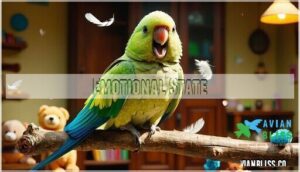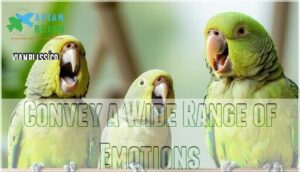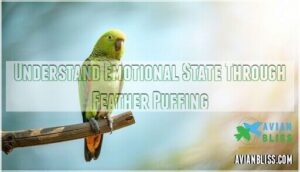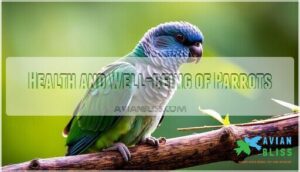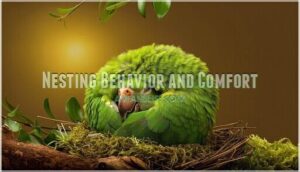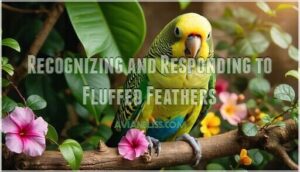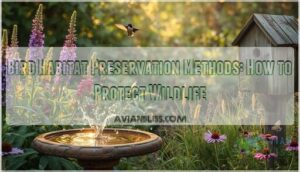This site is supported by our readers. We may earn a commission, at no cost to you, if you purchase through links.

When your feathered friend looks like a fluffy ball, they’re usually seeking comfort and warmth by trapping air close to their body.
This natural insulation helps them regulate temperature, especially during cooler moments or when they’re settling in for rest.
Puffing can also signal your parrot’s emotional state – they might be feeling relaxed, excited, or even mildly anxious.
Sometimes it’s simply part of their social communication, whether they’re interacting with you or asserting themselves.
However, persistent puffing combined with lethargy could indicate health concerns requiring attention.
Understanding these feather signals reveals fascinating insights into your parrot’s daily needs and behaviors.
Table Of Contents
- Key Takeaways
- Why Do Quaker Parrots Puff Up?
- Reasons for Fluffing
- Parrot Behavior and Social Interaction
- Emotion Expression in Parrots
- Health and Well-being of Parrots
- Nesting Behavior and Comfort
- Recognizing and Responding to Fluffed Feathers
- Frequently Asked Questions (FAQs)
- How do Quaker parrots communicate?
- Why do Quaker parrots pluck their feathers?
- Why do Quaker parrots ruffle their feathers?
- Why does a Quaker parrot shake?
- Why do parrots fluff up their feathers?
- Why do parrots puff up and squat?
- What does it mean when a quaker puffs up?
- Why is my Quaker fluffed up?
- How to tell if a Quaker parrot is happy?
- What does it mean when a parrot is fluffed up?
- Conclusion
Key Takeaways
- You can tell your parrot’s emotional state through feather puffing – gentle fluffing means they’re content and relaxed, while rapid or defensive puffing signals anxiety, excitement, or mild stress
- Puffed feathers help your bird regulate temperature naturally – they trap warm air between feather layers to stay cozy during cooler moments or when settling down for rest
- Your Quaker uses puffing as social communication – they’ll fluff up to assert dominance, show submission, attract mates, or simply interact with you and other birds
- Persistent puffing combined with lethargy requires immediate vet attention – while normal puffing is healthy behavior, constant fluffing during active hours often indicates serious illness that needs professional care
Why Do Quaker Parrots Puff Up?
Watching your feathered friend transform into a fluffy ball can spark curiosity about quaker parrot behavior. This parrot body language serves multiple purposes beyond simple feather care.
Your bird’s feather puffing acts as sophisticated avian communication, revealing everything from comfort levels to social signals. Thermal regulation plays a key role—bird fluffing feathers creates insulating air pockets for warmth.
Understanding parrot psychology helps decode when parrot puffing up indicates relaxation, excitement, or mild anxiety. This natural behavior strengthens parrot body language communication between you and your companion, making interpretation essential for proper care.
Recognizing parrot stress signs is essential to provide a comfortable environment for your pet.
Reasons for Fluffing
When you notice your Quaker parrot fluffing up, they’re usually telling you something important about how they’re feeling.
Your feathered friend’s puffed-up appearance is their way of communicating comfort, temperature needs, or emotions without saying a word.
Understanding these signals helps you respond appropriately to your feathered friend’s needs and guarantees their comfort and well-being.
Comfort and Warmth
When your Quaker parrot fluffs up for warmth, they’re using nature’s perfect insulation system.
This feather fluffing creates air pockets that trap heat close to their body, making parrot temperature regulation effortless.
Your bird’s body temperature stays stable through this clever heat conservation method:
- Air trapping between feather layers provides excellent insulation
- Cold adaptation helps them thrive in cooler environments
- Feather insulation minimizes heat loss during chilly periods
This parrot body language signals pure comfort – they’re just staying cozy.
Relaxation and Rest
Beyond warmth, your feathered friend uses parrot puffing up as their relaxation technique. Feather fluffing creates a personal comfort zone during Rest Modes, signaling they’re ready for downtime.
This Cozy Behavior appears during quiet moments, especially before Sleep Patterns begin.
| Relaxation Signal | What It Means |
|---|---|
| Gentle puffing | Content and comfortable |
| Eyes half-closed | Preparing for rest |
| Quiet chirping | Expressing parrot comfort |
Calming Signals like parrot preening often accompany this behavior, showing your Quaker’s truly at ease in their environment.
Health Check
Puffing up isn’t always relaxation—sometimes it’s your bird’s health alarm. Parrot puffing up paired with lethargy or poor appetite signals sick parrot behavior.
Monitor for respiratory issues like tail bobbing, changes in beak health, or abnormal droppings. These parrot illness signs require immediate veterinary care.
Regular feather inspection helps catch problems early, preventing cold parrot symptoms from worsening. Checking for respiratory symptoms is essential for maintaining your parrot’s overall health.
Emotional State
Your parrot’s emotional state directly shapes their puffing behavior.
When feeling anxious, they’ll fluff up defensively, while happiness brings relaxed feather displays.
These emotional signals reveal their mood swings and stress response.
Reading these behavioral cues through feather puffing develops your emotional intelligence, helping you recognize when your bird needs comfort or space.
Excitement, Curiosity, Mild Anxiety
Watch your Quaker’s feather puffing during social stimulation – it reveals emotional triggers like parrot excitement or parrot curiosity.
Excitement behaviors include rapid puffing with vocalizations, while curiosity signs show gradual fluffing when exploring.
Anxiety cues appear as quick, repetitive parrot puffing up paired with restlessness, signaling they need reassurance.
Parrot Behavior and Social Interaction
Quaker parrots use puffing as their main social language to communicate with both other birds and their human companions.
You’ll notice this behavior helps them establish their place in the flock hierarchy, attract mates during breeding season, and signal everything from excitement to submission.
Assert Dominance or Show Submission
When your Quaker establishes social hierarchy, they’ll puff feathers to communicate power dynamics. This body language signals dominance or submission through strategic aggressive posture displays.
Here’s what parrot puffing up means in dominance signals and submission cues:
- Upright stance with puffed feathers – Shows authority and discourages challengers from approaching
- Flattened body with slight fluffing – Communicates peaceful intentions and willingness to yield rank
- Wing spreading plus feather ruffling – Creates imposing appearance during territorial disputes over food
- Quiet puffing with averted gaze – De-escalates tension while maintaining respectful distance from dominant birds
Part of Courtship and Bonding Rituals
During romantic seasons, you’ll witness your Quaker’s courtship displays come alive.
Feather puffing combines with beak clicking and head bobbing as mating signals. These attraction methods showcase their health to potential partners.
Pair bonding strengthens through synchronized displays, while bonding behaviors create lasting connections.
Parrot courtship involves intricate rituals that reinforce social bonds year-round.
Understanding hormonal behavior patterns is essential for supporting your Quaker’s emotional well-being.
Communicate Intentions and Emotions
Your feathered friend’s puffing up serves as sophisticated parrot communication, broadcasting emotional signals through feather puffing.
This emotional expression reveals their inner world, whether showing contentment, requesting attention, or signaling mild stress.
Social cues your parrot sends include:
- Affection displays – gentle puffing during bonding moments shows trust and happiness
- Attention requests – rapid feather fluffing paired with vocalizations means "notice me"
- Discomfort warnings – defensive puffing combined with body language indicates uneasiness
Understanding these parrot emotions helps you respond appropriately to their needs.
Convey Various Messages to Other Parrots
Puffing up creates a complex social signals network among your Quaker’s feathered friends.
This feather puffing serves multiple purposes in flock communication – from threat display when establishing territory to subtle mate attraction cues during breeding season.
Your bird’s body language speaks volumes through parrot puffing, whether issuing warning calls or simply maintaining social bonds through parrot communication.
Interact With Human Companions
Your parrot uses feather displays to communicate directly with you, creating emotional bonds through parrot puffing behavior.
These social interactions show trust building and provide emotional support.
Notice these parrot affection cues:
- Gentle puffing when you approach signals comfort
- Excited fluffing during playtime shows happiness
- Relaxed feathering indicates successful Human Bonding
- Responsive displays demonstrate Social Learning progress
This parrot human interaction strengthens your Companion Care relationship daily.
Emotion Expression in Parrots
Quaker parrots use feather puffing as their primary emotional language, communicating everything from pure contentment to mild anxiety through this simple yet expressive behavior.
You’ll notice your bird’s emotional state shifts throughout the day as they puff up to show excitement during playtime, fluff their feathers when feeling secure and relaxed, or create a defensive posture when something catches them off guard, which can indicate a range of emotions from anxiety to fear, all expressed through the subtle yet significant act of feather puffing.
Sign of Anxiety or Threat
Looking beyond social behaviors, your Quaker puffing up can signal anxiety or perceived threats.
This defensive posture makes them appear larger when feeling vulnerable.
Watch for these stress response patterns to help your bird feel secure.
| Threat Response Signs | What It Means |
|---|---|
| Rapid feather puffing with tail fanning | High alert, ready to defend |
| Puffed body with loud vocalizations | Warning others of danger |
| Defensive posture with head lowered | Preparing for potential conflict |
Understanding these anxiety signs and alarm signals helps you identify when your parrot needs reassurance or environmental adjustments.
Express Excitement, Happiness, or Curiosity
When your Quaker parrot displays feather puffing during social play, you’re witnessing pure joy in action.
This emotional display signals excitement, happiness, and curiosity about their surroundings.
Watch for these excitement cues when introducing new toys or during interactive moments—it’s their way of showing happy behavior and genuine interest in what’s happening around them.
Convey a Wide Range of Emotions
Like a master communicator, your Quaker parrot uses feather puffing as emotional language to express complex feelings.
These behavioral cues reveal their emotional state through subtle stress responses and mood indicators, showcasing remarkable emotional intelligence.
- Joy – Gentle puffing during playtime or treats
- Frustration – Sharp, quick feather fluffing with agitated movements
- Contentment – Relaxed, full-body puffing while perched peacefully
- Nervousness – Rapid puffing combined with alert posturing
- Anticipation – Excited feather ruffling before favorite activities
Understand Emotional State Through Feather Puffing
Reading your Quaker’s emotional signals becomes second nature once you understand their feather language.
Puffed feathers typically mean your bird feels safe and content, while tight, sleek feathers suggest alertness or mild stress.
Watch for subtle behavioral cues like body posture and vocalizations alongside the feather puffing.
This parrot mood indicator helps you respond appropriately to their social clues and emotional needs.
Understanding the concept of parrot puffing behaviors is essential to recognizing your Quaker’s emotional state and responding with appropriate care.
Health and Well-being of Parrots
While puffed feathers often signal normal behaviors like warmth regulation or relaxation, persistent fluffing during active hours can indicate serious health issues requiring immediate attention.
You’ll want to monitor your Quaker parrot closely, as they’re masters at hiding illness until symptoms become severe.
May Indicate Underlying Health Problems
When your bird’s persistent feather puffing extends beyond normal comfort-seeking, it often signals serious trouble.
Respiratory infections, internal parasites, and metabolic problems commonly manifest through constant fluffing. Watch for accompanying signs like lethargy, poor appetite, or unusual droppings.
Your parrot’s instinct to mask illness makes health monitoring through feather conditions your first line of defense against declining parrot health signs.
Maintaining peak health requires understanding parrot health supplements to prevent such issues.
Seek Immediate Veterinary Care
When persistent puffing combines with concerning symptoms, immediate Emergency Care becomes essential for your feathered friend’s survival.
Avian health deteriorates rapidly, making swift Medical Signs recognition imperative. Don’t wait if you notice these parrot health signs:
- Respiratory infections – labored breathing or tail bobbing
- Internal parasites – weight loss with increased appetite
- Parrot shivering – trembling while puffed up
Veterinary Checks can’t wait when Health Alerts appear. Your quick response provides the Urgent Attention your Quaker needs.
Regular Check-ups and Vigilant Observation
Your parrot’s health depends on regular checkups and vigilant observation.
Schedule routine veterinary care every six months to catch issues before they become serious.
Watch for behavioral signs like persistent feather puffing, appetite changes, or lethargy.
Use simple observation techniques – notice your bird’s daily patterns, droppings, and energy levels.
These preventive measures help detect parrot health problems early when treatment works best.
Nesting Behavior and Comfort
You’ll notice your feathered friend transforms into a fluffy ball when seeking comfort, especially during rest periods or cooler moments.
This natural nesting behavior helps them create a cozy microclimate by trapping warm air between their feathers, mimicking the insulation they’d find in their wild colonial nests, which is a key aspect of their natural behavior to seek comfort.
Creating an Insulating Layer of Air
When you notice your Quaker parrot fluffing up, they’re creating nature’s perfect insulating layer.
This clever air trapping mechanism works through multiple feather layers that capture warm air pockets close to their skin.
Thermal regulation becomes effortless as feather puffing enhances heat conservation naturally.
Your bird’s body temperature regulation relies on these sophisticated insulation methods, making this behavior both practical and fascinating to observe.
Understanding bird insulation techniques and materials can provide valuable insights into their natural behaviors.
Trapping Warmth Close to The Body
When your Quaker parrot fluffs up, it’s like wrapping itself in a down comforter.
The feather puffing creates multiple air pockets between feather layers, forming natural insulation that traps warm air close to the skin.
This body temperature regulation technique maximizes warmth retention through efficient heat conservation, helping your bird maintain ideal comfort without wasting precious energy, which is crucial for its overall well-being and energy efficiency, and ultimately supports its ability to thrive with proper temperature regulation.
Conserving Heat in Colder Environments
Watching your Quaker parrot bundle up like a feathered snowball during chilly nights reveals remarkable thermal regulation. This cold adaptation strategy transforms their feathers into nature’s perfect insulation system through feather fluffing.
Here’s how heat conservation works:
- Feather insulation creates air pockets that trap warm air against their skin
- Winter behavior includes constant puffiness during rest periods in cool environments
- Parrot climate adaptation allows them to survive temperature drops that would challenge other birds
This parrot temperature regulation isn’t just smart—it’s essential survival instinct at work.
Maintaining Ideal Body Temperature
Temperature control becomes second nature for your Quaker parrot through sophisticated thermal regulation systems.
Their feathers act like a multilayered thermostat, using air trapping techniques between feather layers for ideal insulation methods.
When they puff up, they’re creating personalized heat conservation zones that maintain perfect parrot warmth.
This thermoregulation process showcases remarkable parrot temperature sensitivity, automatically adjusting their natural parrot insulation system to achieve optimal parrot warmth.
Adapting to a Wide Range of Climates
Remarkable adaptability defines these parrots.
Your Quaker’s feather insulation works through air layering, creating thermal barriers for temperature control.
Their climate adaptation skills let them thrive from South American heat to North American winters.
This thermoregulation system adjusts automatically—fluffing creates warmth pockets in cold, while lifting feathers promotes cooling airflow in heat.
Their environmental adaptation explains why feral populations survive harsh climates worldwide.
Understanding bird adaptation strategies is essential for appreciating the resilience of Quaker parrots in various environments.
Recognizing and Responding to Fluffed Feathers
You’ll want to watch your Quaker parrot’s body language carefully to understand what their fluffed feathers are telling you.
The key is knowing when puffing up signals comfort versus concern, so you can respond appropriately to keep your feathered friend happy and healthy.
Observing Closely
When your Quaker puffs up, watch for context clues.
Notice whether they’re puffing up during preening, social interactions, or rest periods.
Their body language and behavioral signs tell the whole story—relaxed birds show different visual cues than stressed ones.
Observation tips: Look for accompanying sounds, posture changes, and timing patterns to decode their feather puffing messages accurately.
Checking The Environment
Check room temperature – drafts and temperature fluctuations trigger puffing as your bird attempts thermal regulation.
Look for environmental stressors like sudden loud noises, new furniture, or changed lighting.
Your parrot’s environmental adaptation skills mean they’ll puff for climate response and air insulation.
Address environmental factors promptly – move perches away from vents, reduce noise, and maintain consistent temperatures for ideal environmental comfort.
Monitoring Health
Health checks become your best friend when deciphering persistent puffing behaviors.
Watch for concerning patterns that signal medical attention:
- Behavioral Signs: Lethargy, appetite loss, or unusual vocalizations alongside puffing
- Medical Alerts: Continuous fluffing during active hours, not just rest periods
- Feather Inspection: Ragged appearance, stress bars, or abnormal preening habits
Regular veterinary care helps catch early warning signs before they become serious health issues.
Monitoring a parrot’s health status online can provide valuable insights into their well-being.
Building Trust
Building strong parrot trust requires patience and consistency.
You’ll notice Trust Signals when your Quaker feels comfortable puffing up around you—this feather puffing shows they’re relaxed.
Create Bonding Rituals through gentle interactions and respect their Social Cues.
Your Emotional Intelligence grows as you understand their Relationship Dynamics, making trustbuilding feel natural rather than forced.
Understanding the basics of feather structure analysis can also help you better recognize your Quaker’s behavior and body language.
Respecting Subtle Cues
Paying attention to your parrot’s feather puffing reveals their emotional intelligence and behavioral signals.
When you notice puffing up, respect their social boundaries by reading their parrot body language carefully.
These parrot subtle cues guide proper feather care and strengthen your bond.
Understanding their parrot emotional expression helps you respond appropriately to their needs.
Frequently Asked Questions (FAQs)
How do Quaker parrots communicate?
Your feathered friend‘s got quite the conversational toolkit – they’ll puff up their plumage, bob their heads, and vocalize through chirps, squawks, and even mimicked words to express emotions, establish social hierarchies, and bond with you.
Why do Quaker parrots pluck their feathers?
Your Quaker parrot plucks feathers due to stress, boredom, medical issues, or hormonal changes.
Poor diet, lack of stimulation, environmental changes, or underlying infections can trigger this behavior.
Consult an avian vet promptly.
Why do Quaker parrots ruffle their feathers?
Your parrot ruffles feathers to regulate temperature, communicate emotions, and show comfort. They’ll fluff up when cold, excited, relaxed, or establishing social hierarchy with you.
Why does a Quaker parrot shake?
Bird owners witness shaking in roughly 60% of their feathered companions during temperature regulation.
Your Quaker shakes when cold, excited, or stressed.
They’ll vibrate their skin to fluff feathers for warmth, show enthusiasm during play, or release nervous energy when overstimulated to manage their nervous energy.
Why do parrots fluff up their feathers?
Your feathered friend fluffs up for temperature control, trapping warm air between layers. They’ll also puff when relaxed, excited, or communicating emotions to you and other birds.
Why do parrots puff up and squat?
Your parrot’s puffing and squatting typically signals comfort or mating behavior.
They’ll fluff feathers when relaxed, sleepy, or bonding with you.
The squatting motion often indicates affection or reproductive instincts, especially in female birds.
What does it mean when a quaker puffs up?
When your Quaker puffs up, it’s expressing comfort, regulating temperature, communicating emotions, or signaling illness. You’ll see this behavior during relaxation, cold weather, social interactions, or when they’re unwell.
Why is my Quaker fluffed up?
Like a Victorian lady reaching for her smelling salts, your fluffed-up Quaker’s probably just staying cozy, feeling content, or trying to look impressive during social interactions with you.
How to tell if a Quaker parrot is happy?
Watch for relaxed body language like gentle feather puffing while perched, cheerful vocalizations, active preening, playful behavior, bright eyes, healthy appetite, and comfortable interaction with you—these signal contentment.
What does it mean when a parrot is fluffed up?
Picture your feathered friend transforming into a fluffy cotton ball—that’s feather fluffing in action.
When you see your parrot puffed up, they’re likely regulating temperature, expressing emotions, or signaling comfort and relaxation in their environment.
Conclusion
Understanding why do quaker parrots puff up transforms you from a telegraph operator frantically sending messages to a fluent interpreter of avian communication.
You’ve learned that puffed feathers aren’t just adorable—they’re your parrot’s way of expressing comfort, emotions, health status, and social intentions.
By recognizing these signals, you’ll build stronger bonds with your feathered companion and respond appropriately to their needs, ensuring they remain happy and healthy, which is a key aspect of being a fluent interpreter.
- https://www.parrotfunzone.com/learn-about-parrots/parrot-behavior/why-does-my-bird/fluff-up
- https://myrightbird.com/articles/how-to-decode-your-birds-body-language
- https://www.parrotforums.com/threads/knowing-when-a-quaker-is-sick.77930/
- https://www.mit.edu/~rei/Birds-sick.html
- https://pubmed.ncbi.nlm.nih.gov/30244665/




